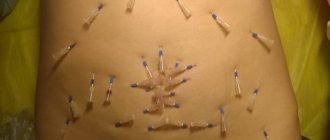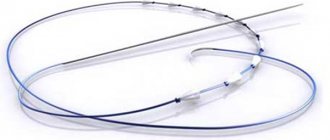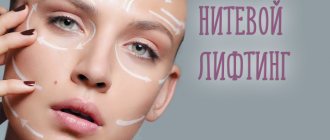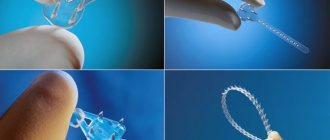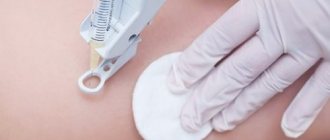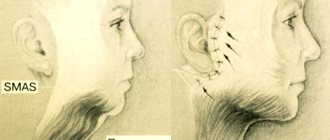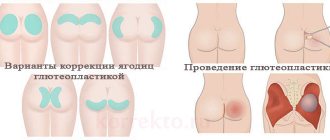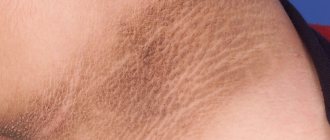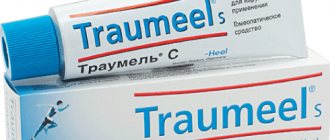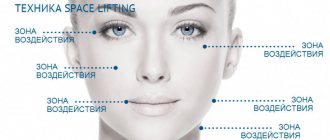The essence of the procedure
Thread reinforcement began to be made in the middle of the last century.
Then thin gold threads were used and they were installed only on the face. However, with the development of modern self-absorbable materials, their scope has expanded significantly, and they are now used to correct any part of the body. When administered subcutaneously, mesothreads form an additional elastic frame that supports soft tissues. Over time, a shell of connective tissue forms around them, which prolongs the result and increases the elasticity of the skin. Thus, she tightens up and her condition noticeably improves.
When she's useless
In recent years, the procedure has begun to be actively used to correct the buttocks. However, it does not always achieve good results. It all depends on the condition of the muscles and skin.
The problem is that the elastic thread frame cannot support large volumes of soft tissue. Moreover, excessive tension can lead to the threads breaking and even coming out. Therefore, reinforcement of the buttocks is not performed:
- with significant excess weight;
- loss of muscle tone;
- severe drooping of the buttocks;
- large excess skin;
- patients over 60 years of age.
The procedure is not suitable for those who are actively involved in sports. After it, you will have to give up heavy physical activity for at least 3-4 months, and then constantly ensure that you do not accidentally injure your buttocks.
Advantages and disadvantages
However, if the skin and gluteal muscles are still in good condition, then thread lifting has a number of advantages over other lifting methods:
- does not leave visual marks - the threads are installed through punctures that heal in just a few days;
- does not require the use of anesthesia - local anesthesia is sufficient;
- short rehabilitation – complete recovery takes no more than 4 weeks, and active recovery – up to 7-10 days;
- immediate effect - it can be seen immediately after the procedure, and within a month it only intensifies;
- skin improvement - threads stimulate the production of collagen and elastin, and also increase capillary blood flow.
If necessary, the procedure can be repeated after 2-3 years, and with proper skin care and exercise, the effect can actually be extended up to 5 years.
This method has few disadvantages. The main thing is its rather high cost, since such a large area requires at least 10-14 threads, the price for each starts from 1000 rubles. On too thin and loose skin after lifting, strands may appear - reddish marks reminiscent of stretch marks.
Filament lifting of the buttocks
We know a lot about thread lifts for the face and neck, but what about the buttocks? In what cases will threads help maintain appetizing shapes, and for how long? Alternatively, filament lifting . This is a fairly minimally invasive buttock lift procedure using threads, which can in many cases replace plastic surgery, although its effect is temporary. This technique is often identified with the Brazilian butt lift, which, however, is not entirely correct: the latter uses not threads, but the patient’s own fat to correct the shape of the gluteal muscles.
Buttock lift with threads - filament lifting 7670
Filament lifting of the buttocks: will not always help everyone
So, for some good reason, you decided that fitness won’t help you tighten up your buttocks, buttock plastic surgery is still too drastic an option, but still, it really wouldn’t hurt to tighten up the sagging areas on your buttocks... Well, your choice is filamentlifting!
Many people would like to lift their buttocks - the process of drooping (ptosis) of the skin and soft tissues of the buttocks is inevitable, unless you are constantly and seriously involved in athletics or bodybuilding. It is divided into two stages:
- Preptosis: when a fold of skin begins to form at the border of the buttock and thigh;
- Ptosis itself: a fold is formed and the tissue of the buttocks begins to hang over the skin fold.
Unfortunately, filament lifting is effective only in the case of the first stage, that is, preptosis: the threads in this case allow you to slightly lift the skin and model, “group” the subcutaneous fatty tissue. This helps to create volume in the upper part of the buttocks and, most importantly, prevents further sagging of the tissue. At the stage of ptosis, filament lifting will provide an effect, but only temporary. It is important that the risk of complications increases, such as cutting through threads and the formation of strands in the “firmware” areas.
In addition to the problem of sagging, filament lifting also solves the following problems: flat or asymmetrical buttocks; too small disproportionate buttocks; changes in the shape of the gluteal muscles after massive weight loss.
Butt lift: suture material options
Now is the time to talk about the options for threads that are used to lift the buttocks.
- Absorbable sutures made of polylactic acid. Polylactic acid gradually degrades in the tissues of the dermis and subcutaneous fat with the subsequent formation of lactic acid. Lactic acid, in turn, stimulates tissue metabolism and also activates the synthesis of collagen and elastin. In addition to the revitalizing effect, threads made of polylactic acid act mechanically: they have notches for fixing tissues in a given position. Ideally, after the thread has completely dissolved, a matrix will remain in its place, a framework consisting of new collagen and elastin, which will prevent recurrent ptosis - but this rosy scenario is only possible at a young age. However, if you consider that threads made of polylactic acid dissolve within 6-9 months, then you can be sure that they will provide a sufficiently long-lasting lifting of the buttocks in any case.
- Polypropylene threads - they have microscopic notches that allow you to securely fix the tissue in a certain position. Polypropylene threads do not dissolve. As a rule, they do not cause hypersensitivity or rejection reactions.
- Mesothreads. If the first two types are used to correct sagging skin and underlying tissues of the buttocks, then mesothread lifting is used only to prevent ptosis. However, mesothreads are the choice of those who would like to preserve their shape for as long as possible. The fact is that on the one hand there are no notches on them, therefore mesothreads cannot provide a significant degree of tissue tension and, accordingly, lifting. Mesothreads consist of polydioxanone and are coated on top with polyglycolic acid. However, on the other hand, during the degradation process, mesothreads stimulate the production of collagen and elastin in the skin and form a frame that will support the skin in a certain position.
Filament lifting procedure
A buttock lift with threads can take from 30 to 60 minutes. To perform filament lifting, local anesthesia is used. The place where the threads are inserted is treated with antiseptics, and then the threads are inserted using needles or cannulas (through punctures of different diameters) around the circumference of the buttocks. After all the threads have been inserted, they are tensioned, and their ends are secured and trimmed.
Buttock lift with threads 9100
In some cases, you can observe the process of tightening the threads and adjust the degree of their tension and, accordingly, the appearance of the buttocks.
Filament lifting of the buttocks 8182
After removing the cannulas and cutting the ends of the threads, the puncture sites are treated with an antiseptic and sealed with adhesive tape. It is imperative that cold is applied to the site where the threads are inserted for about an hour to reduce tissue swelling and to prevent bruising.
Rehabilitation after filament lifting
It is very important to avoid cutting through the threads and other complications of filament lifting, for example, “reformatting” of the dermal tissue and subcutaneous fat, which ends in the formation of ugly bumps and depressions along the course of the threads. It is also necessary to reduce swelling of the skin and prevent its increase. It is equally important to prevent infection. So the recovery period requires compliance with a number of restrictions of at least 20 days: this is how long it takes to form a capsule of connective tissue around the threads. So it follows:
- treat puncture sites with antiseptics, and in the first days you can apply cold to the buttocks;
- if you are concerned about pain, you can take analgesics as needed.
- reduce physical activity, avoid wide-range movements in the hip joints, as well as movements with significant muscle effort (sharp lifting of something heavy, for example);
- do not massage the tightening area;
- Any thermal procedures are not recommended, not only visiting the sauna and solarium, but also taking a hot bath.
The entire recovery period can take up to one and a half months.
Benefits of filament lifting
If we compare thread lifting with buttock surgery:
- No postoperative scars: when inserting threads, there is no need to make large incisions, so there are no scars or, especially, scars left.
- No anesthesia required. The procedure is minimally invasive, so there is no need to resort to general anesthesia.
- Short rehabilitation period. When inserting threads, tissue damage is minimal, so recovery after the procedure is quick.
- Stimulating effect on the dermis at the treatment site. Blood flow and metabolism increase at the injection site. If threads made of polylactic acid or mesothread are used, the processes of tissue rejuvenation at the injection site are additionally stimulated.
Disadvantages and possible complications of filament lifting
The main disadvantage is the transient effect: usually the result of filament lifting lasts about a year. In this case, the tightened volume decreases gradually, returning to its original level. Many specialists who are responsible for the long-term results of butt lifts refuse to perform butt lift with threads altogether, as they consider this procedure to be a short-lived and controversial solution to the problem. Their arguments are quite reasonable: the buttocks are too large and strong muscles to be supported by “threads”. The following complications can spoil the impression of the procedure:
- The formation of strands - such a picture greatly spoils the appearance of the “fifth point”. It usually occurs with the problem of excessively loose tissue of the buttocks. In those places where the threads pass, the tissues are tightened. And in the spaces between the threads they become bulging.
- Thread cutting. In this case, the threads go deeper into the tissue than they were introduced, and the tissues pulled up by the threads are lowered.
- Thread contouring. In this case, the threads move to more superficial layers of tissue and begin to be felt or visually visible under the skin. Unlike teething, this complication is very rare.
- Development of infection in the area of insertion of threads. This complication develops when the conditions of the procedure are violated and requires removal of the suture material in order to avoid inflammation of the subcutaneous fatty tissue and subsequent scar formation.
It is impossible to predict the risk of development of such complications - a lot depends on the doctor. Also, you should not rely too much on advertising promises - they say that the thread lift process is absolutely safe and this method has practically no contraindications. They exist, just not as strict as in the case of buttock surgery.
- Pregnancy and lactation;
- Risk of formation of keloid or hypertrophic skin scars in response to injury;
- Infectious (including colds) and autoimmune diseases;
- Oncological diseases;
- Blood diseases, disorders of blood clotting processes;
- Diseases of the skin and subcutaneous tissue of any location;
- Diabetes.
- Allergy to thread material;
If you decide to tighten your buttocks using this method, choose a specialist very carefully, study reviews of his operations, recommendations and portfolio. Additionally, surgical techniques for a Brazilian butt lift vary widely among plastic surgeons. The technique your doctor uses will influence not only the result, i.e. the shape of the buttocks, but also how long it will last.
Types of threads
Modern threads made of organic and inorganic materials are used to lift the buttocks. The most common types are:
- "Silhouette Elevator". Long thin polypropylene threads reinforced with lactic acid knots. They gradually dissolve and are replaced by sections of connective tissue, which prevents the thread from moving from the installation site. The effect of the procedure lasts at least 2-3 years.
- "Aptos". The threads of this manufacturer have different configurations. To reinforce the buttocks, double spirals or smooth threads with knots and notches are usually used. The surgeon decides which ones are best, depending on the volume of fat, the condition of the muscles and skin.
- Mesothreads. The most inexpensive, but not very suitable for correcting the buttocks. They are made of polypropylene and are very smooth. Therefore, they cannot be firmly fixed and may become dislodged over time. But they are in demand due to their affordable price (from 750 rubles) and effectiveness in the fight against cellulite.
- Polypropylene. Threads with micro-notches made of synthetic high-tech fiber, thanks to which they can be tightened and fixed in the desired position. An additional plus is their reasonable price, which is why they have become super popular. In addition, they are hypoallergenic and rarely provoke allergies or rejection.
It is better to entrust the choice of threads to a specialist, since he knows all the features of each type and will make the right decision, focusing on the volume of the buttocks and the condition of the skin.
Types of threads
- Made from polylactic acid (absorbable). Gradually dissolving in the tissues, these threads form lactic acid, which stimulates the synthesis of collagen and elastin, as well as metabolic processes. After the thread disintegrates, a collagen-elastin framework remains that supports the tissue. The resorption process takes about 9 months.
- Polypropylene (non-absorbable). They have microscopic notches, due to which they reliably hold the tissue in the desired position. They are hypoallergenic and non-rejection free.
- Mesothreads (absorbable). They are used not for correction, but for the prevention of tissue ptosis, since they do not have notches. During the resorption process, they stimulate the production of elastin and collagen, creating a natural supporting frame.
Preparation and Execution
Installing threads on the buttocks is easy. There is no large accumulation of nerve endings and blood vessels in this area, so the risks of serious complications are minimal. The entire procedure rarely takes more than one hour and does not require lengthy preliminary preparation.
Preliminary consultation
During the initial examination, the doctor assesses the degree of changes in the skin, the volume of fat deposits and the general condition of the body. He carefully interviews the patient to ensure there are no contraindications. If there is no doubt, a date is set for the procedure.
To make rehabilitation go faster, it is advisable to quit smoking and stop drinking alcohol two weeks before. During this same period, you must completely stop taking anticoagulants to eliminate the risk of bleeding and reduce the number of bruises.
Execution technique
Immediately before lifting, markings are made on the patient’s buttocks, which show the insertion points and direction of the threads. This is necessary, since in a lying position the muscles take on a different shape and without marks it is difficult for the doctor to navigate.
Then the working area is treated with an antiseptic and injected with sensitivity-reducing drugs. Small punctures are made at pre-designated points, through which thin metal cannulas are inserted under the skin.
The threads are pulled through them, positioned along the muscle fibers, the soft tissues are fixed in the desired position, the ends are secured and the excess is cut off. The puncture sites are sealed with an antiseptic plaster. 20-30 minutes after the procedure, the patient is allowed to go home.
Rehabilitation
In the first few days after a thread lift, swelling and slight redness of the skin are observed. Minor pain may occur in the places where the threads are attached. They usually go away within 3-4 days.
You can go to work within a day after the procedure. But for at least two weeks you will have to comply with the following restrictions:
- do not sit for too long without a break;
- do not play sports;
- do not visit the sauna and solarium;
- do not swim in the pool or open water;
- don't steam in the bathroom.
To help bruises and swelling go away faster, you can apply cold, dry compresses to your buttocks in the first days. The puncture sites should be treated with an antiseptic at least twice a day until complete healing.
To enhance the effect, you need to wear high-quality compression garments for at least a month. The use of a good anti-cellulite or lifting cream can prolong the result.
Recovery period
Both procedures are minimally invasive, so patients can return to their normal lives much faster than after conventional facelift surgery. A small amount of swelling and bruising will soon subside. If necessary, the doctor prescribes painkillers.
Normal activities, without strenuous activities, can be resumed the next day.
The fibrous capsule around the cones forms within 20 days, so some restrictions must be observed during this time.
Exercise, swimming or bathing should be postponed during this time. You can take a shower after 24 hours, but you can take a bath no earlier than 3-4 days later, and sometimes longer. Visiting the sauna or solarium is not recommended.
The second procedure has the same limitations.
Possible complications
With a well-performed procedure, complications and side effects after it are extremely rare and usually the culprits are the patients themselves, who did not follow medical recommendations.
Most often they encounter the following problems:
- A break or cutting through the threads occurs when they are improperly fastened, hit or when there is strong pressure on the buttocks.
- Contouring – occurs in people with a tendency to form keloid scars or when threads are installed incorrectly.
- Distortion of the relief - soft tissues rise in the area where the threads are installed, forming depressions between them.
- Infection of wounds is a consequence of their improper or insufficiently thorough treatment.
- Thread rejection is almost impossible to predict, but in this case they will have to be removed.
Most serious complications are the result of medical errors and can only be corrected by repeated correction.
Contraindications
Although a thread lift is not a full-fledged operation, it is associated with certain risks and has a number of contraindications. Reinforcement of the buttocks is not performed when:
- pregnancy and breastfeeding;
- tendency to form scars;
- blood clotting disorders;
- active viruses and infections;
- skin diseases, psoriasis;
- hypertension and diabetes mellitus;
- exacerbation of chronic diseases;
- oncology and autoimmune diseases.
Thread lifts are not performed on patients under 18 and over 55 years of age. The procedure is not prescribed during menstruation or a few days before and after it.
Main indications
Both women and men may face the need to correct the gluteal area, although the number of the former certainly prevails due to a more attentive attitude to their appearance and high demands on it. Before deciding to undergo lifting procedures, it is important to familiarize yourself with the cases in which they are indicated and what contraindications exist for their implementation.
Indications for butt lift:
- sudden weight gain or loss;
- age-related changes (deformation of contour and shape, sagging and sagging skin);
- wide, voluminous buttocks from birth;
- flat and sagging posterior pelvis;
- individual aesthetic preferences of the patient and his dissatisfaction with the shape, size and contours of the buttocks.
The procedure is not performed for those who are obese, diagnosed with diabetes, chronic diseases of internal organs, endocrine disorders and pathologies of the cardiovascular system.
